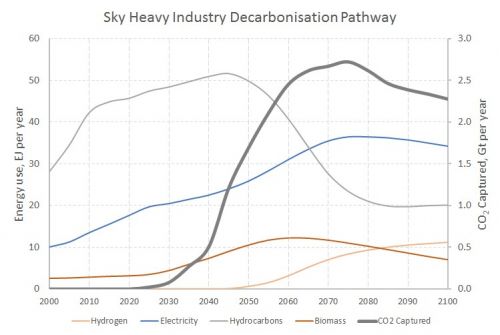本文转自《Peak Oil News》发布的题为“Decarbonising Heavy Industry”的报道。
日期:2017.05.31
原文链接:http://peakoil.com/consumption/decarbonising-heavy-industry
I was fortunate to attend part of the 9th Clean Energy Ministerial (CEM) meeting in Copenhagen and participate in a panel focussed on the steps required to decarbonise the industrial sector. It is good to see that the CEM is bringing much needed focus to this area, given that industrial emissions make up about a fifth of global energy system emissions, without including process CO2, such as from the cement industry.
我很幸运参加了在哥本哈根举行的第九届清洁能源部长会议(CEM),并参加了一个专门讨论工业部门脱碳所需步骤的小组。 由于工业排放占全球能源系统排放量的五分之一左右,而不包括水泥工业中的二氧化碳,CEM给这一领域带来了急需的关注,这是件好事。
Shell recently released the Sky scenario, which tackles the challenge of meeting the goals of the Paris Agreement. In Sky, as power sector emissions decline with natural gas replacing coal and rapid deployment of renewables, industrial emissions become increasingly important. By 2040 in Sky, when global emissions have declined by nearly 20%, heavy industry emissions have actually increased. This is the result of continued development and urbanization which increases the demand for materials such as cement, ferrous and non-ferrous metals and a broad range of chemicals.
壳牌最近发布了“蓝天方案”,该方案解决了实现“巴黎协定”目标的挑战。 在蓝天中,随着天然气替代煤炭和可再生能源的快速应用,电力行业的排放量下降,工业排放变得越来越重要。 到2040年,在全球碳排放量下降近20%时,重工业排放量实际上有所增加。 这是持续发展和城市化的结果,这增加了对水泥,黑色金属和有色金属以及各种化学品等材料的需求。
The solution for industry in Sky, which aligns with the discussions held in Copenhagen, includes a number of different directions, all of which require significant action. In Sky, the shift in industry required for net-zero emissions follows an incremental path, largely driven by the progressive implementation of government carbon-pricing systems and the ratcheting up of the resultant price that occurs as governments respond to the Paris Agreement. The transformation is profound and follows three distinct routes:
蓝天行业的解决方案与哥本哈根的讨论相一致,其中包含许多不同的方向,所有这些都需要采取重大行动。 在蓝天中,净零排放所需的工业转移遵循一条增量路径,主要由政府碳定价系统的逐步实施以及随着政府对巴黎协议的回应而导致的最终价格的增长所驱动。 转型是深刻的,遵循三条不同的路线:
- Efficiency improves continuously, with most industrial processes approaching thermodynamic and mechanical efficiency limits by the 2050s.
- 效率不断提高,到本世纪50年代,大多数工业过程的热力学和机械效率都将接近极限。
- Some processes shift towards electricity, particularly for light industry, where electricity use doubles from 2020 to 2040. Hydrogen also emerges as an important fuel for light industry by 2050 as natural gas use declines. But a similar change for heavy industry doesn’t emerge until after 2050, with hydrogen, biomass, and electricity substituting for natural gas and some coal use.
- 一些工艺转向电力,尤其是轻工业,从2020年到2040点,轻工业的用电量翻了一番。到2050年,随着天然气使用量的下降,氢气也成为轻工业的重要燃料。 但直到2050年之后,重工业的类似变化才会出现,氢气,生物质能和电力替代天然气和一些煤炭的使用。
- Coal remains important in the metallurgical sector and some other processes right through the century, but with government-implemented carbon prices rising, carbon capture and storage (CCS) emerges as the solution.
- 煤炭在冶金行业和其他一些过程中依然重要,但随着政府实施的碳价格上涨,碳捕获和封存(CCS)成为解决方案。
Industry also benefits from an increased focus on the circular economy, which sees large-scale recycling expand throughout the century, to the extent that some resource extraction declines as a result.
工业也受益于对循环经济的更多关注,这种循环经济将在整个世纪内实现大规模循环利用,从而导致一些资源开采量下降。
For heavy industry, which was the focus of discussions in Copenhagen, the Sky decarbonisation pathway is illustrated below.
对于在哥本哈根进行讨论的重点行业而言,天空脱碳途径如下所示。

Although electricity and biomass use grow in Sky, the first major change is the application of CCS from the late 2020s, just a decade away. In the 2030s some 500 major heavy industry CCS projects emerge (1 million tonnes stored CO2 per annum per project), with that rate of uptake more than doubling into the 2040s. By the time net-zero emissions is achieved globally for the energy system, over 2.5 Gt of CO2 is being captured and stored from energy use in heavy industry. In addition, there will be further use of CCS capturing CO2 from limestone calcining in the cement industry.
虽然在天空行业中,电力和生物质的使用都在增长,但第一个重大变化是在本世纪20年代末,也就是仅仅10年后,开始应用CCS技术。在本世纪30年代,出现了大约500个大型重工业CCS项目(每个项目每年储存二氧化碳100万吨),到本世纪40年代这个比率增加了一倍多。在全球范围内实现能源系统零净排放时,超过2.5G吨的二氧化碳被捕获并储存在重工业的能源使用中。此外,还将进一步使用CCS从水泥行业的石灰石煅烧中捕获二氧化碳。
After 2050, hydrogen emerges as an alternative energy source for heavy industry and its growth eventually begins to reduce the need for CCS, which declines from the mid-2070s. Today the use of hydrogen in heavy industry is in the earliest stages of development, with a pilot plant proposed for hydrogen based iron ore smelting in Sweden. Given progress to date, it is unlikely that this technology will emerge at scale prior to mid-century. Large facilities may exist by then, but probably not numerous enough to make a material difference to emissions.
2050年之后,氢气作为重工业的替代能源而出现,其增长开始减少对CCS的需求,CCS技术的发展将从20世纪70年代中期开始下降。目前在重工业中氢的使用处于发展的最初阶段,在瑞典建立了一个用于氢型铁矿石冶炼的中试工厂。鉴于迄今取得的进展,这项技术不可能在本世纪中叶之前大规模出现。到那时大型设施可能会存在,但可能不足以对排放产生重大影响。
With electrification of some sectors, along with hydrogen use in others, fossil fuel use in heavy industry falls rapidly in Sky from the early 2050s. By 2100, heavy industry emissions have fallen from a peak of 4.6 Gt per year in 2040, to less than a tenth of that. Remaining emissions are offset by atmospheric drawdown via BECCS.
从20世纪50年代早期开始,随着电气化和氢的使用,重工业的化石燃料使用将在天空中迅速下降。到2100年,重工业的排放量已经从2040年的每年4.6G吨的峰值下降到不到十分之一。 剩余排放量通过BECCS大气压降补偿。
As was highlighted in the Copenhagen meeting, for such a pathway to succeed, much needs to be put in place throughout the 2020s. CCS in industry must be catalysed, process technologies using electricity and hydrogen require research, development and commercialisation and a more aggressive focus on efficiency needs to be encouraged and incentivised.
正如哥本哈根会议强调的那样,为了取得成功,在整个21世纪20年代都需要进行大量的工作。 工业中的CCS必须加以催化,使用电力和氢气的加工技术需要研究,开发和商业化,需要鼓励和激励更加积极地关注效率。
And to kick-start that process in earnest, the Clean Energy Ministerial offered an opportunity to announce a fresh initiative aimed at boosting the progress on CCS. The Carbon Capture, Utilization, and Storage (CCUS) Initiative will focus on strengthening the framework for building collaborative partnerships on CCUS between the public and private sectors. It will also bolster and complement existing CCUS efforts led by the Carbon Sequestration Leadership Forum, the International Energy Agency (IEA), the IEA’s Greenhouse Gas R&D Programme, Mission Innovation, and the Global CCS Institute.
为了启动这一进程,清洁能源部长提供了一个机会,宣布旨在推动CCS进展的新举措。 碳捕集,利用和储存(CCUS)倡议将侧重于加强公私部门CCUS之间建立合作伙伴关系的框架。 它还将加强和补充碳封存国家领导人论坛(CSLF),国际能源机构(IEA),国际能源署温室气体研发计划,使命创新和全球碳捕集与封存研究所领导的CCUS工作。
Led by the United States, Norway, and Saudi Arabia, other international partners that have joined this initiative include Canada, China, Japan, Mexico, Netherlands, United Arab Emirates, and the United Kingdom; as well as the European Commission.
由美国,挪威和沙特阿拉伯为首的其他国际合作伙伴加入了这一倡议,其中包括加拿大,中国,日本,墨西哥,荷兰,阿拉伯联合酋长国和英国, 以及欧盟委员会。